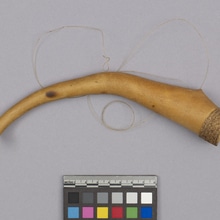
Penis Sheath
MOA: University of British Columbia
2948/113
Penis sheath. A curving bottle gourd with a woven rattan band around the open end. A synthetic line is tied to the rattan band at one end, and appears to have been originally attached to the sheath’s tip. The gourd is cracked at the open end with one edge overlapping the other. This appears to be...

Penis Sheath
MOA: University of British Columbia
2948/112
Penis sheath made of a crescent-shaped bottle gourd that is broken at the open end. Here, it is folded inward to create a smaller opening which is wound with a plant fibre strip. The gourd has several scorch marks.

Penis Sheath
MOA: University of British Columbia
2948/111
Penis sheath is a crescent-shaped bottle gourd with a 2cm band of woven rattan fibre clasped around the thick end and a thin bast string attached to the band. Remnants of lime remain on the band and string. The small end is sealed.
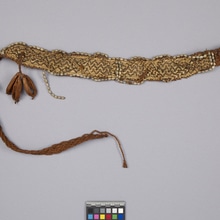
Belt
MOA: University of British Columbia
2948/108
Woven belt consists of yellow-brown and dark-brown plant fibres woven to form horizontal zigzagging lines. On top are two plaited, crossing cords which form four diamond patterns. This is bordered and interspersed by rows of threaded coix seeds. On the left-hand side is a tassel of ruddy-brown sa...
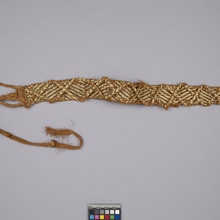
Belt
MOA: University of British Columbia
2948/107
Woven belt has ten rows of light and dark sago leaf strips that have been woven over the top of ruddy brown sago fibres, forming diagonal lines. Two criss-crossing braids of these three colours are attached above this, forming diamond shapes. One end is a thick braided loop, the other has three t...
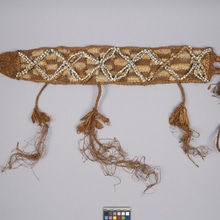
Belt
MOA: University of British Columbia
2948/106
The main body of the belt is 11 cm high with twelve columns consisting of six horizontal painted stripes alternating between dark brown terracotta ochre and yellow-brown and white pigment(faded). This is surrounded by a border of ruddy-brown plaits with a broad loop on the left end and a tightly ...
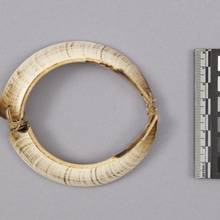
Arm Ornament
MOA: University of British Columbia
2948/57
Two boar tusks tied closely together with rattan through small drill holes at both ends. The rattan at the root ends has some residual pigment or adhesive on it. There are two holes at this hollow end on each tusk which the rattan tie goes through.

Arm Ornament
MOA: University of British Columbia
2948/56
Two boar tusks tightly bound together at the root ends with rattan through small drill holes. A 22cm-long string of sago leaf fibre with two knots passes through a drill hole near one of the tips. This section has broken off the other tusk which is missing one complete side from base to tip.

Arm Ornament
MOA: University of British Columbia
2948/55
Two boar tusks tied together by twisted rattan, running through small holes drilled in the ends. The opposite ends of the tusks were also once connected by rattan, which has now come loose from one side.
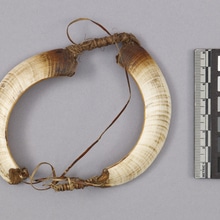
Arm Ornament
MOA: University of British Columbia
2948/54
Two boar tusks with small holes drilled through both ends. The root ends are tied together, 3.5cm apart, with a strip of sago leaf through single holes. The tips are tied together with rattan. Both tips are broken.